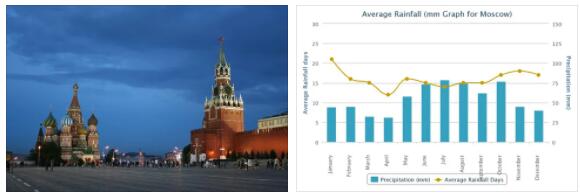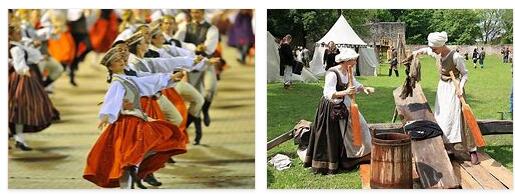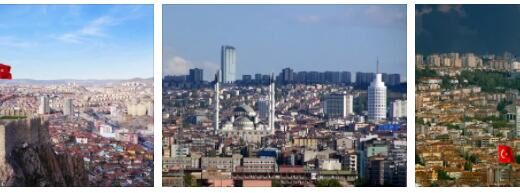Russia Climate
The essential characteristics of the Russian climate are continentality and relative uniformity over vast surfaces; both in evident relationship with what has been mentioned about the morphology and above all the coastal contour of Eastern Europe. The seas affecting the Sarmatian region, apart from the fact that they result from more or less closed basins, are either too far away, or too limited in extent, to exert a decisive influence on the large continental mass, while the lack of well marked reliefs exclude or greatly limit the possibility of notable contrasts within restricted spaces, as is usually the case in central European areas. The only exception concerns the extreme southern sector of Crimea, where the Jajla mountain barrier determines, on the side facing the Black Sea, the appearance of a strip of Mediterranean climate, albeit attenuated. The Urals themselves, as has been said, also given their longitudinal arrangement, remain without effect on the behavior of the areas that flank them. The uniformity of the climate is then favored by the equalizing effect of the air currents in the extreme seasons: in winter, because the mild ocean winds (coming from W), which temper the excessive rigors in N., contrasts with S. cold breath of those crawling on the circumcaspian steppes, coming from the interior of Asia; in the summer, since the longer period of insolation in the northern regions has a similar effect, because it is equally compensatory, to that of the ocean currents (always originating in the W) on the opposite side of the continent.
Precisely for this reason in Russia the greatest contrasts do not consist so much in the behavior of temperatures, but in the duration of the extreme seasons. Kola, Moscow and Astrakhan, which are mutually distant over 13 ° and 22 ° in latitude, have an average temperature not very different in January (−11 °, 2 against −10.8 and −7 °, 2), but while in the first location the thermometer remains below 0 ° for over 6 months, in the second this period is reduced to 5 months and in the last to just over 3. Southern Russia enjoys an earlier and longer summer, but d ‘winter, the whole flat selvedge that borders the Black Sea from the N. marks minimums at least as low (−40 °, 8 in Lugansk, −31.4 in Poltava) as the polar tundra, where, on the other hand, not infrequently it exceeds 30 ° in the shade in summer.
The winter is almost everywhere more severe than in other parts of Europe at the same latitude; the average temperatures in January are all below 0 °, except in the small Mediterranean strip of Crimea, where they reach 3 °, 7 ° (Yalta); the opposite extremes descend to below −24 ° along the last northern slopes of the Urals and in the lower basin of the Pečora. The decisive influence exerted by the cold currents resulting from the persistence of high pressure areas in the interior of Asia is clearly demonstrated by the longitudinal rule of the isochemene; temperatures tend to decrease more from W to E. than from S. to N., except in the extreme NE corner, where, once the mitigating efficacy of the westerly winds is canceled, that of latitude returns to be felt. As a result, Kiev has an average January temperature lower than that of Hammerfest, which is 20 ° further north; Astrakhan equals the North Cape, the northernmost point in Europe, in the same month; Taganrog on the Black Sea and Kola on the Murmanian coast have the same winter averages, while in the north-eastern sector there are differences of 6 ° to 8 ° within distances of about 10 ° of latitude. Winter is generally early – in most of the country it already starts at the end of September – but relatively dry; in addition to the snowfall and long frosts, its sad fame is due to the violence and frequency of the winds and the sudden changes in temperature that characterize it. Although it corresponds to a period of forced stagnation in agricultural work, this season is of paramount importance in the Russian economy.1 / 2 months a year in the Black Sea area to over 7 along the Northern Ocean) make it easy in every sense. On the other hand, with the melting of the snow, most of the communication routes, reduced to muddy marshes or completely obliterated by the waters, become useless (the so-called rasputica period), while the thawing of the rivers is sometimes determined so suddenly, that constitute a danger for navigation, even if it does not turn into ruinous floods.
Fortunately, the brief spring interlude usually corresponds to the driest period of the year (April); on the other hand, the summer, which is the wettest, coincides with such high values, as to activate a very strong evaporation everywhere; therefore the level of the rivers tends to decrease, despite the rains. Moreover, the latter often fall, at least throughout southern Russia and in most of central Russia, in the form of violent, but short showers (up to 60 mm. In 10 minutes), to which are added, with equal frequency, the damage produced in the same regions by the transport of dust, conveyed by air currents that originate from the usual imbalance between the circumponic depressions and the high pressures of central Asia. The influence of the humid ocean winds (NW) is evident in the course of the isotera: at the same latitude, temperatures increase as we proceed towards the S. and especially towards the SE, where (circumcaspian western limb) the highest average values are reached in July, which is the hottest month everywhere (25 °, 3 at the mouth of the Ural; 25 °, 2 in Astrakhan). In this case too, the lowest values belong to the selvedge of the Arctic tundra (8 ° at the mouth of the Pečora, 6 °, 5 in Novaya Zemlya); as for the absolute maximums, on the other hand, the difference is not very noticeable between south and center (43 °, 1 in Astrakhan, 41 ° in Orenburg, 39 °, 2 in Tambov, 37 °, 5 in Moscow). The inland localities of Russia are, in summer, warmer than those of central and western Europe at the same latitude (25 °, 2 in Astrakhan against 21 °, 2 in Lyon);
Atmospheric precipitations are usually not very abundant; the 4 / 5 of the country they receive a quantity of water less than 500 mm., and for large sectors even 400. The maximums refer to the region of the Urals, where they touch and exceed 700 mm. on average per year (Ufa: 726 mm.); relatively well watered are the region of the upper Dnieper (Smolensk: 650 mm.) and that of the great lakes (Kalininsk: 579 mm.). The upper Volga and the Oka basin also mark values higher than half a meter almost everywhere (Moscow: 533 mm.). On the other hand, the whole flat sector near the Caspian suffers from low quantities (Astrakhan: 162). In general, rainfall decreases from the W to the East. and especially to the SE, as well as from the sea towards the interior and especially towards the steppe regions. The number of rainy days does not decrease in the same sense, because in S. the precipitations are less regularly distributed and often take on a stormy nature; from 178 days with rain in Novgorod to 74 in Yalta (the minimum), through sensitive and capricious fluctuations. More normal is the rhythm of the rains according to the seasons: from 2 / 5 to 1 / 3 of the average annual quantity falls in the summer, where in winter you have as a rule, less than 1 / 5, and sometimes just 1 / 7 or 1 / 8 of the total. The proportions tend to change from N. to S., in harmony with the gradual transition from the European-center arrangements to those attenuated Mediterranean, which is realized along the edge of the mountainous Tauride: here more than 1 / 3 in fact, rainfall falls in autumn, while in Odessa the summer percentage is already reduced to 29%. To the lesser amount of rain that affects the sectors of S. and especially of SE. there is added a greater variability from year to year, an element of great importance for agriculture, whose conditions, in those sectors, cannot fail to appear extremely precarious.
A winding line that from the mouth of the Gulf of Finland through the middle Daugava (Dvina dell’O.), The upper Dnepr (Mogilev), the upper Don (Voronez) and the middle Volga (Kamyšin) cuts the course of the Ural around 50 ° N. wholesale marks the southern limit of the area where the snow remains on the ground for more than 4 months. In the north of this line, cold climates of the Siberian or polar type dominate (the latter in a large belt around the Arctic Ocean and the Urals); to S. more or less decisive continental climates, which in the regions around the Euxine and the Caspian gradually pass into the steppe ones, whose distinctive character is given by a gradually increasing aridity towards the SE. The southern coast of Crimea, on the reverse of the Jajla, represents, as we have said, a thin Mediterranean oasis.



